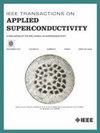基于开源频域模拟器的约瑟夫森行波参量放大器磁链可调谐性建模
IF 1.8
3区 物理与天体物理
Q3 ENGINEERING, ELECTRICAL & ELECTRONIC
引用次数: 0
摘要
约瑟夫森行波参量放大器(jtwpa)是量子技术中许多实验中不可或缺的组成部分。由于由数百个基于约瑟夫森结的单元组成,这种器件表现出复杂的非线性行为,通常不能用简单的分析模型完全解释,因此需要使用数值模拟器。jtwpa的一个非常有用的特性是可能受到外部磁通的偏置,允许对非线性进行原位控制。因此,数值模拟器非常需要支持这个特性。开源数值工具允许模拟JTWPA通量偏倚,如WRSPICE或PSCAN2,基于时域方法,通常需要较长的模拟时间才能获得准确的结果。在这项工作中,我们利用JosephsonCircuits对一个典型的磁通可调谐JTWPA的增益性能进行了建模。Jl是最近开发的一个频域开源数值模拟器,它的仿真速度比时域方法快10000倍左右。通过比较数值和实验结果,验证了该方法对jtwpa通量依赖行为的建模效果。本文章由计算机程序翻译,如有差异,请以英文原文为准。
Modeling Flux Tunability in Josephson Traveling Wave Parameteric Amplifiers With an Open-Source Frequency-Domain Simulator
Josephson traveling wave parameteric amplifiers (JTWPAs) are integral parts of many experiments carried out in quantum technologies. Being composed of hundreds of Josephson junction-based unit cells, such devices exhibit complex nonlinear behavior that typically cannot be fully explained with simple analytical models, thus necessitating the use of numerical simulators. A very useful characteristic of JTWPAs is the possibility of being biased by an external magnetic flux, allowing in-situ control of the nonlinearity. It is, therefore, very desirable for numerical simulators to support this feature. Open-source numerical tools that allow to model JTWPA flux biasing, such as WRSPICE or PSCAN2, are based on time-domain approaches, which typically require long simulation times to get accurate results. In this work, we model the gain performance in a prototypical flux-tunable JTWPA by using JosephsonCircuits.jl, a recently developed frequency-domain open-source numerical simulator, which has the benefit of simulation times about 10 000 faster than time-domain methods. By comparing the numerical and experimental results, we validate this approach for modeling the flux dependent behavior of JTWPAs.
求助全文
通过发布文献求助,成功后即可免费获取论文全文。
去求助
来源期刊

IEEE Transactions on Applied Superconductivity
工程技术-工程:电子与电气
CiteScore
3.50
自引率
33.30%
发文量
650
审稿时长
2.3 months
期刊介绍:
IEEE Transactions on Applied Superconductivity (TAS) contains articles on the applications of superconductivity and other relevant technology. Electronic applications include analog and digital circuits employing thin films and active devices such as Josephson junctions. Large scale applications include magnets for power applications such as motors and generators, for magnetic resonance, for accelerators, and cable applications such as power transmission.
 求助内容:
求助内容: 应助结果提醒方式:
应助结果提醒方式:


